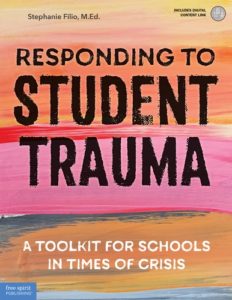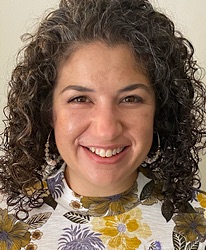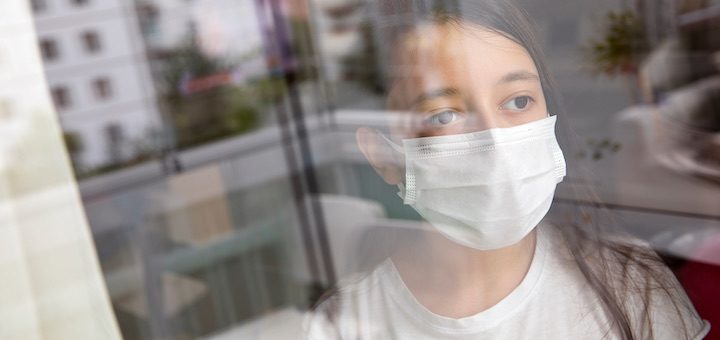Student Trauma in 2020 and How We Can Help
We all know that the middle years come with their own set of challenges. The hormones, the emotions, the pressures, those nagging adults – oh my!
My own counseling students will often come to my middle school-based office upset and actually say, “I have no idea why I’m crying! I’m not even sad! This is crazy!” And I just sit back, let them cry, and tell them, “yep, sounds about right.” It’s tough, and each day is likely to serve up a new crisis.
These days we all feel a bit battered. We are in this huge transition, riding a wave of unexpected changes, predicaments, and hazards. Our students are right there with us, but unfortunately for them, so too are all of the normal developmental dangers that come with adolescence.
The year 2020 has brought many things – an international pandemic, social unrest, economic hardship, a divided nation – but there is also no reprieve from the other normal emotional clutter of growing up.
A Traumatic Cyclone
With all the personal battles and the simultaneous national and international traumas, there is now a cyclone of ramifications affecting our students. Let’s consider some of the examples of trauma our students are experiencing in their personal selves and home lives that may have already been present, but are now likely magnified or festering anew:
- mental illness (of self or a caregiver)
- experiences with prejudice
- abuse in the home
- loss of housing and/or resources
- substance abuse (of self or caregiver)
- injury or death of a caregiver or close family member
- identity development and struggle (including lack of support)
What heavy, heavy burdens for our children to bear. Some of these difficulties are a result of typical complications associated with the transition into individuation, while others (like pandemic quarantine/isolation) are layered over those developmental dilemmas.
As our students show up to school, they are carrying with them all of the crises they are experiencing from home. Many of them are beginning to internalize this trauma because they do not have the tools or support to properly process their emotions. We might see this in grades dropping, social isolation, loss of appetite, or behavior changes, among other things.
In “normal” school times, it is relatively easy to monitor data of students displaying overt responses to stress and trauma and identify those who are in need of social emotional strengthening. But what about less obvious reactions?
Think about that student who lingers in the counselor’s office doorway, or takes extra long leaving the classroom after the bell. Maybe you have a student who is constantly questioning or double-checking instructions, disbelieving every bit of validation you give them.
What about the student who always makes jokes and begins to be disruptive whenever you discuss goals and/or the future? These children may very well be struggling with trauma at home as well, bottling their emotions and even trying to resolve adult issues that they have no control over.
The School’s Role in Trauma Response
The student that scratches and covers their ears when they are frustrated breaks our hearts, but there are also many students who have constructed protective boundaries between themselves and their school because of trauma at home that’s consuming their attention.
These children would benefit from an environment that tells them that they are welcome at the school; they will be protected in an orderly environment designed specifically for them.
The school can implement supports for students who are struggling emotionally at many levels – from school-wide interventions to individualized supports that will help the child process their personal crises, as well as chaotic trauma on a larger scale (as we have right now) in their city and country.
Supports that help students through trauma are those that restore a sense of safety and strong self. We want these students to feel in control of some aspects of their lives, so that they can develop and employ resilience by gradually becoming empowered by their experiences rather than victimized.
In order to build resilience, students need a better understanding of processes of the emotional mind, as well as tools to best cope with intense stress and anxiety. Consider whether these implementations would work in your school or with students in your care during these times:
Student: Use Intervention Central (RTI) to create individualized goal sheets and behavioral intervention lists.
Small Groups: Pick a Cooperative Learning Technique (here’s a collection) and teach students about their own mental health. (Also see my post “Reducing the Stigma of Mental Illness in Middle School.”) This may be in-school or online.
Class: Make a classroom lesson based on principles of the Personal Bill of Rights by having students choose a right each week to think about daily (extra points if you can tie it to your content area).
Whole school: Forgo the standard morning announcements for a day and teach all students how to use 4×4 or “box” breathing to calm down. Play the Just Breathe video from Mindful Schools.
Trauma on a Large Scale
Keep in mind that when we first meet our students, we are unaware of what they have been through in their lives. Some students may speak freely about traumas they have experienced, while other students will not.
We know that all students have been connected to some form of trauma during this pandemic year, and many had existing crises at home or internally or have encountered additional layers of trauma as COVID-19 and social justice issues work their way through our society.
Because of this, we need to always be in a state of readiness to help. We need to build our student support toolboxes to best handle the difficulties they are facing. We can also make our schools safe and welcoming, and make sure all our students benefit from interventions and programs that help them exercise their mental health, whether we are aware of their trauma history or not.
Begin by examining the resources shared here and work with your school counselor to identify ways the whole adult community in your school can be more proactive in developing a culture that recognizes and addresses the ever-present trauma affecting our students’ ability to grow, learn and be happy.

Prior to school counseling, Stephanie worked in private education, specializing in standardized tests, test preparation, and future planning. She writes about her career and hobbies at her blog, Weekend Therapy, and can be found on Twitter @steffschoolcoun.




































